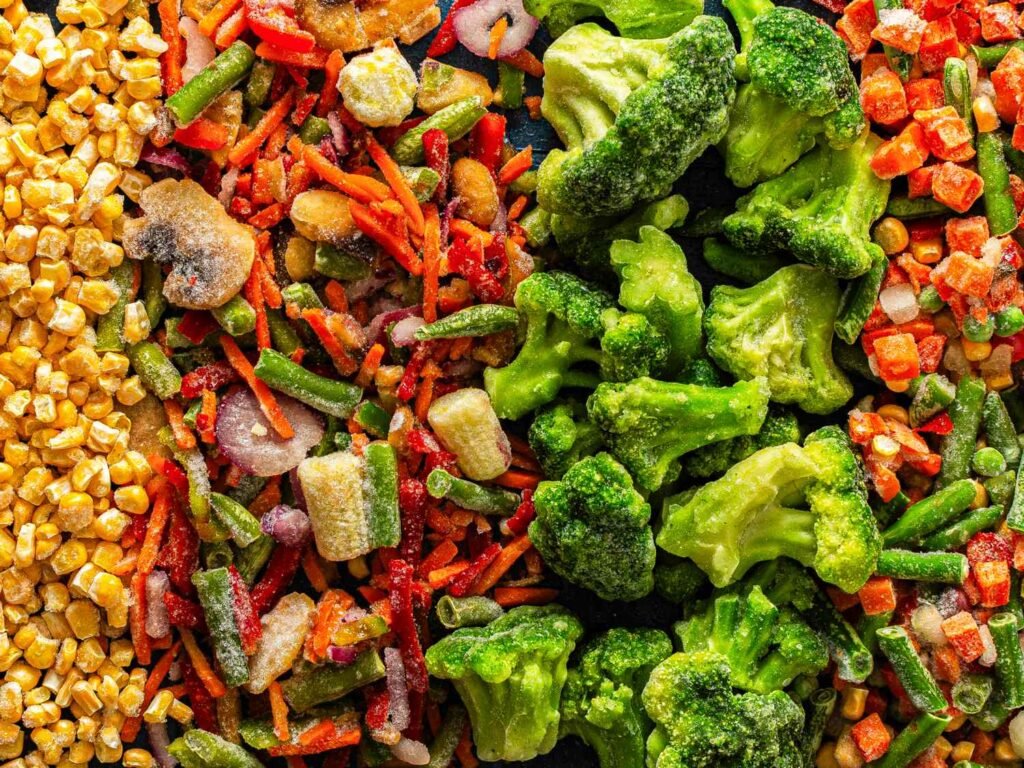I look forward to pea season all year long: The season—just a few weeks in April—is heartbreakingly short, so when peas appear at the farmers market, I snap them right up. Though I don’t usually purchase fresh peas when they’re out of season, my craving for the vegetable got the better of me one January. I bought a package of fresh peas from the grocery store, hoping to make a simple salad. I shelled and blanched the vegetables, only to find them laughably small and lacking the signature sweetness of the spring peas I love. Disappointed but still eager for my salad, I made the recipe again the next evening—except this time, I reached for frozen peas, and was rewarded with delicious pops of sweetness. I was pleasantly surprised: Until that moment, I had turned my nose up at frozen peas. The ingredient has since become a staple, and I never leave the grocery store without it.
It’s a common misconception that fresh vegetables are superior to frozen ones. While that is the case for certain produce—leafy lettuce and raw tomatoes are two obvious examples—many store-bought frozen vegetables are just as (if not even more) flavorful and tender to prepare. They’re also incredibly convenient, and having frozen vegetables stocked can save you from going without veggies when your fridge is bare. It all comes down to choosing the right frozen vegetable for the job, which requires understanding how they’re frozen.
A Bit of Frozen Vegetable Science
Once picked, many vegetables—including peas, corn, and carrots—rapidly convert their sugars to starches, resulting in a loss of sweetness. There’s a considerable difference in sweetness between a freshly picked pea and one that’s been sitting out for a day; the latter tends to be a bit tougher, too.
Most frozen food manufacturers follow a precise formula: Once picked at peak ripeness, the vegetables are blanched and immediately flash-frozen, which locks in the sugars and prevents the vegetables from becoming starchy. Blanching helps reduce the number of microorganisms on the surface of vegetables, while freezing halts their growth. (When the vegetables thaw, however, any surviving bacteria can resume multiplying, which can rapidly lead to spoilage.) The vegetables are then packed and shipped to grocery stores.
It’s not only the freezing that matters—it’s the quality of the freezer, too. Unlike home freezers, industrial freezers are powerful enough to flash-freeze vegetables in minutes. The difference in the quality of rapidly frozen and slowly frozen vegetables is considerable, and comes down to ice crystallization: Fruits and vegetables mostly consist of water trapped inside individual cells. As they freeze, the water forms ice crystals. Speed matters: The slower the freeze, the larger the ice crystals. Larger ice crystals can rupture cell walls, causing the produce to become mushy when thawed. Rapid freezing, on the other hand, creates smaller ice crystals, minimizing cell wall damage and helping prevent sogginess when the vegetables are cooked.
The Best Vegetables to Buy Frozen
Here are a few of my favorite vegetables to buy frozen—they all maintain their flavor and texture beautifully, and save a ton of prep time.
Serious Eats / Jen Causey
Peas
Fresh peas are at their peak for just a few weeks in the spring and don’t hold up long once harvested. Plus, they are tedious to shell.
Frozen peas, on the other hand, are picked at peak ripeness and come shelled, making them a delicious and convenient option. And if you don’t use a whole bag, you can stash it away for later, knowing they’re there if you need them. I’ll happily reach for frozen peas when preparing salads, pasta, and quick stir-fries.
Corn
Nothing beats sweet, juicy, fresh corn on the cob, whether you’re eating on the cob or slicing the kernels from the cob to make a salad or another dish, but in the off-season, when fresh corn falls short, the frozen version still delivers. And sometimes, you might not want to shuck six ears of corn or deal with all that silk. While techniques like the inverted bowl method make shucking easier, there’s no shame in choosing convenience. Frozen corn is a reliable, sweet, and convenient option, ready whenever you need it. My favorite ways to use it are in soups and chowders, salads, and creamy corn casserole.
Spinach, Broccoli, and Green Beans
I don’t always buy these vegetables frozen, but they work well in a pinch—and save me from having browning, wilted vegetables lurking in the back of my fridge. Frozen spinach is great in creamy dips, curries, and lasagna. Similarly, I reach for frozen broccoli and green beans when I make stir-fries, soups, or even sheet-pan dinners.
How to Cook With and Use Frozen Vegetables
Once you have your frozen peas, corn, and carrots handy, how do you cook with them? You might be tempted to thaw your frozen vegetables, since that’s the usual move for frozen ingredients like meat and stock. But resist the urge: When vegetables are frozen, ice crystals puncture their cell walls. Once the vegetables are thawed, all that liquid gets released at once and pools around the vegetables, leading to mushiness and diluted flavor.
Instead, cook the vegetables straight from frozen. While it depends on the recipe, it’s usually a good idea to cook the vegetables over high heat: Adding the vegetables to a hot pan helps drive off excess surface ice and ensures that the vegetables have less time to sit in their own water. Then, toss the vegetables into your favorite grain bowls, soups, fried rice, risotto, and even hummus—and serve them, knowing that frozen vegetables can often be just as good as fresh ones, if not better.

